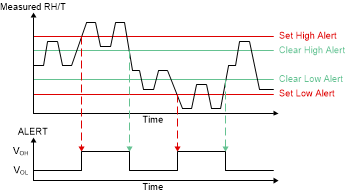SNAS817D June 2021 – November 2024 HDC3020-Q1 , HDC3021-Q1 , HDC3022-Q1
PRODUCTION DATA
- 1
- 1 Features
- 2 Applications
- 3 Description
- 4 Device Comparison
- 5 Pin Configuration and Functions
- 6 Specifications
-
7 Detailed Description
- 7.1 Overview
- 7.2 Functional Block Diagram
- 7.3
Feature Description
- 7.3.1 Factory Installed Polyimide Tape
- 7.3.2 Factory Installed IP67 Protection Cover
- 7.3.3 Wettable Flanks
- 7.3.4 Measurement of Relative Humidity and Temperature
- 7.3.5 RH Offset Error Correction: Accuracy Restoration
- 7.3.6 NIST Traceability of Relative Humidity and Temperature Sensor
- 7.3.7 Measurement Modes: Trigger-On Demand vs Auto Measurement
- 7.3.8 Heater
- 7.3.9 ALERT Output With Programmable Interrupts
- 7.3.10 Checksum Calculation
- 7.3.11 Programmable Offset of Relative Humidity and Temperature Results
- 7.4 Device Functional Modes
- 7.5
Communication
- 7.5.1 I2C Interface
- 7.5.2 I2C Serial Bus Address Configuration
- 7.5.3 I2C Write - Send Device Command
- 7.5.4 I2C Read - Retrieve Single Data Result
- 7.5.5 I2C Read - Retrieve Multi Data Result
- 7.5.6 I2C Repeated START - Send Command and Retrieve Data Results
- 7.5.7
Command Table and Detailed Description
- 7.5.7.1 Reset
- 7.5.7.2 Trigger-On Demand
- 7.5.7.3 Auto Measurement Mode
- 7.5.7.4
ALERT Output Configuration
- 7.5.7.4.1 ALERT Output: Environmental Tracking of Temperature and Relative Humidity
- 7.5.7.4.2 ALERT Output: Representation of Environmental Thresholds and Default Threshold Values
- 7.5.7.4.3 ALERT Output: Steps to Calculate and Program Environmental Thresholds
- 7.5.7.4.4 ALERT Output: Deactivation of Environmental Tracking
- 7.5.7.4.5 ALERT Output: Transfer Thresholds into Non-Volatile Memory
- 7.5.7.5 Programmable Measurement Offset
- 7.5.7.6 Status Register
- 7.5.7.7 Heater: Enable and Disable
- 7.5.7.8 Heater: Configure Level of Heater Current
- 7.5.7.9 Read NIST ID/Serial Number
- 8 Application and Implementation
- 9 Device and Documentation Support
- 10Revision History
- 11Mechanical, Packaging, and Orderable Information
Package Options
Refer to the PDF data sheet for device specific package drawings
Mechanical Data (Package|Pins)
- DEF|8
Thermal pad, mechanical data (Package|Pins)
Orderable Information
7.5.7.4.1 ALERT Output: Environmental Tracking of Temperature and Relative Humidity
The primary use of the ALERT output is to provide a signal notification of ambient temperature and relative humidity measurements that violate programmed thresholds. There are a total of four programmable thresholds for temperature and four for relative humidity, as documented in Table 7-4 and illustrated in Figure 7-16 below.
 Figure 7-16 ALERT Programmable Environmental
Thresholds
Figure 7-16 ALERT Programmable Environmental
ThresholdsThe four programmable thresholds are listed below
- Set High Alert: Asserts ALERT output when HDC302x-Q1 measures a temperature or relative humidity level that has risen above this value.
- Clear High Alert: Deasserts the ALERT output caused by Set High Alert, once HDC302x-Q1 measures a temperature or relative humidity level that has fallen below this value.
- Set Low Alert: Programmed value that asserts ALERT output when HDC302x-Q1 measures a temperature or relative humidity level that has fallen below this value.
- Clear Low Alert: Programmed value that deasserts the ALERT output caused by Set Low Alert, once HDC302x-Q1 measures a temperature of relative humidity level that has risen above this value.
If the user application uses the ALERT output for environmental tracking, the best practice is to program these four thresholds prior to any temperature or relative humidity measurement acquisition. Programming enough separation between the Set versus Clear thresholds is important because a small distance between Set and Clear levels can cause the ALERT pin to toggle high and low due to measurement noise.